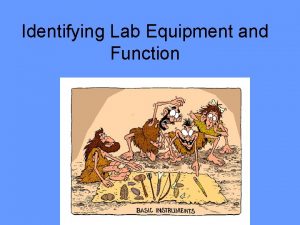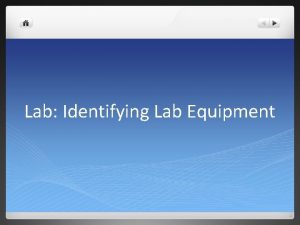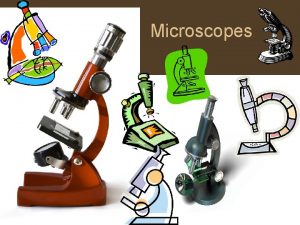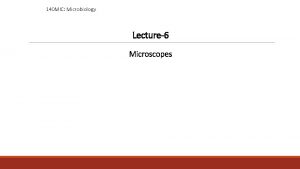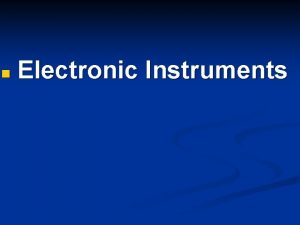MICROSCOPES MICROSCOPES Instruments used to examine things that










- Slides: 10

MICROSCOPES

MICROSCOPES • Instruments used to examine things that are usually too small to be seen with the unaided eye. • Use glass lenses to produce magnified (enlarged) or larger-than-life images (representations or pictures) of objects.

1. LIGHT MICROSCOPES • Use beams of light to magnify an image. • Simple Light Microscope • Contains only 1 lens or lens system. • Compound Light Microscope • Contains more than 1 lens or lens system (EMS)

2. ELECTRON MICROSCOPES • Use beams of electrons to magnify an image. Examples: • Transmission Electron Microscope (TEM) • Sends a beam of electrons through an object to produce a flat-looking two-dimensional image. • Scanning Electron Microscope (SEM) • Bounces electrons off the surface of an object to produce a threedimensional image.

LIGHT VS. ELECTRON Light Microscope Magnification Technique Maximum Magnification Electron Microscope Use beams of light Use beams of electrons 1500 x Over 250000 x 0. 0002 mm or 0. 2 m 0. 000 7 mm or 0. 0007 m live dead Max resolving power or limit of resolution Type of Specimens

MICROSCOPE TERMS • Specimen • Organism you are looking at • Magnification • Extent to which an organism is enlarged • Resolving power • Ability to show objects or parts of objects as separate • Affects the sharpness of an image • Beyond the limit of resolution, objects get blurry and detail is lost • Ex. Human eye = 0. 1 mm • Illumination • Brightness of the field of view • Depth of field • Thickness of the image that is in focus at any one time when a specimen is viewed with a microscope.

FIELD OF VIEW (FOV) • The circular area you are actually viewing • Decreases as you increase magnification 1 2 • LOW power 40 x FOV= 2. 6 mm 0 0. 5 1 MEDIUM power 100 x FOV = 1. 5 mm 0. 5 HIGH power 400 x FOV= 0. 8 mm

METRIC CONVERSIONS • Since specimens are very small, we will often use micrometers (µm) • 1000 µm = 1 mm • 10, 000 µm = 1 cm • 1, 000 = 1 m • Ex. 3. 4 mm = ______ µm 3. 4 mm x 1000 µm = 3400 µm 1 mm

ACTUAL SIZE • Calculating the ACTUAL SIZE of your specimen Actual size = field of view (FOV)_____ # of specimens that fit across the field Ex. Find the actual size of this specimen: • 15 cells fit across HIGH power 0. 8 mm = 0. 053 mm or 53. 3 µm 15 cells

MAGNIFICATION • When you draw a diagram of your specimen, you must calculate how many times bigger it is than the actual size. Magnification = Drawing size Actual size • When you use this formula, the units must be the SAME before you divide. Ex. If the actual size of the paramecium is 40 µm, calculate the drawing’s magnification 25 mm -> 25, 000 µm = 625 X 40 µm
 Which laboratory tools can be used to magnify small objects
Which laboratory tools can be used to magnify small objects Pointed object used to examine specimens
Pointed object used to examine specimens Thơ thất ngôn tứ tuyệt đường luật
Thơ thất ngôn tứ tuyệt đường luật Con hãy đưa tay khi thấy người vấp ngã
Con hãy đưa tay khi thấy người vấp ngã Thơ thất ngôn tứ tuyệt đường luật
Thơ thất ngôn tứ tuyệt đường luật Tôn thất thuyết là ai
Tôn thất thuyết là ai Phân độ lown
Phân độ lown Walmart thất bại ở nhật
Walmart thất bại ở nhật Gây tê cơ vuông thắt lưng
Gây tê cơ vuông thắt lưng Block xoang nhĩ
Block xoang nhĩ Tìm độ lớn thật của tam giác abc
Tìm độ lớn thật của tam giác abc
